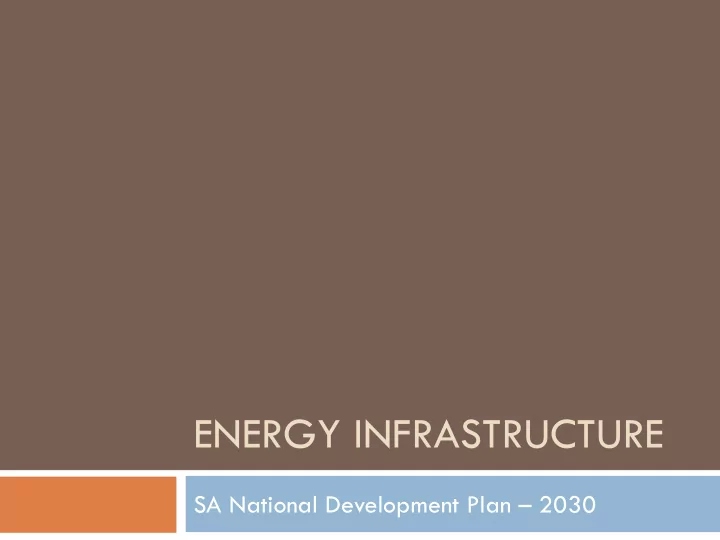

ENERGY INFRASTRUCTURE SA National Development Plan – 2030
Empowering South Africa The NDP envisages that by 2030, SA will have an energy sector that promotes: Economic growth and development through adequate investment in energy infrastructure. The sector should provide reliable and efficient energy service at competitive rates, while supporting economic growth through job creation Social equity through expanded access to energy at affordable tariffs and through targeted, sustainable subsidies for needy households. Environmental sustainability through efforts to reduce pollution and mitigate the effects of climate change. More specifically: Adequate supply security in electricity and in liquid fuels such that economic activity, transport and welfare are not disrupted. Prices for energy are likely to be higher in the future, but will still be competitive compared to SA’s major trading partners More than 90% of the population should enjoy access to grid connected or off-grid electricity To realise this vision, SA’s energy system needs to be supported by effective policies, institutions, governance systems, regulation and where appropriate, competitive markets
Energy System of 2030 Coal will contribute proportionately less to primary-energy needs Gas and renewable energy resources – wind, solar, imported hydro - will play a much larger role Public transport will be highly developed Imported hybrid and electric vehicles will be more widely used Energy intensity of the economy will continue to decline Energy efficient options will be widely available and increasingly adopted Energy market will be more diverse with greater opportunities for investors to provide innovative, sustainable energy solutions Credible and predictable regulatory frameworks
Key Policy Issues and Planning Priorities Growth in coal exports needs to be balanced against the need for domestic coal- supply security Gas should be explored as an alternative to coal for energy production There needs to be a greater mix of energy sources and greater diversity of independent power producers (IPPs) in the energy industry Municipal electricity-distribution services need to be improved Electricity pricing and access need to accommodate the needs of the poor The timing and/or desirability of nuclear power and a new petrol refinery need to be considered
Phasing: Short Term Amend the National energy regulator Act (2004) and Develop a national coal policy and investment strategy Electricity Regulation Act (2006) to ensure more based on realistic coal reserve estimates, sustainable efficient and predictable regulatory environment. supply for domestic needs and sustainable export Ring fence electricity distribution businesses of 12 markets. largest municipalities and resolve their maintenance and refurbishment backlogs. Invest in new heavy-haul rail corridor to Waterberg coalfields. Develop a sustainable national electrification plan. More in-depth investigations into implications of greater Strengthen rail infrastructure in central coal basin and nuclear energy use resulting in a final decision line to Richard’s Bay. Agree on funding mechanism for upgrading of existing Do exploratory drilling for economically recoverable refineries to meet new fuel standards coal seam and shale gas reserves. NPC to work with DOE on an interdepartmental process to develop and update integrated energy plans. Develop West Coast off-shore gas for power production by contracting private sector. Introduce a vehicle point-of-sale carbon tax based on their carbon emission levels Promote investment in LNG landing infrastructure. Encourage greater use of hybrid or electric vehicles Commission Eskom’s Medupi and Ingula power station. and public transport Contract at least 3725MW renewable energy from private sector. Pass the ISMO bill, including transfer of Eskom’s transmission assets.
Phasing: Medium Term Coal rail capacity will match coal export port capacity at Richard’s Bay Commission Kusile power plant Contract at least 7000MW of renewable energy from private IPPs LNG infrastructure in place to power first CCGT Pro-poor electricity tariffs will be better targeted to include all qualifying users Electrification coverage reach at least 85% Decision on SA should continue importing petroleum products or invest in new refinery
Phasing: Long Term More than 20,000MW of renewable Rising energy prices, economy wide energy contracted carbon tax, direct action (IRP , scaled taxes on vehicles, equipment and Rail and port capacity increased to building standards, energy efficiency support coal exports programmes ) will drive SA’s energy 11,000MW of Eskom coal power sector on a path to lower carbon and plants decommissioned energy intensity 6,000MW of new coal capacity At least 90% of South Africans will contracted have grid access Promotion of cleaner coal Hybrid and electric vehicles more technologies widely used Power generation from coal seam and shale gas
The Role of Regulators While some network industries (e.g. power generation) lend themselves to competition, core components such as the electricity grid and pipelines tend to form natural monopolies. With high fixed costs and decreasing average costs of service provision as more customers join the networks, it is often difficult to encourage multiple market entrants. In such cases, effective economic regulation is essential. Regulators are confronted by two challenges: first, to make sure that there are adequate levels of investment to ensure customers get reliable services, and second, to ensure that pricing levels are managed in a way that creates certainty and mitigates against shocks. This requires: A closer working relationship between regulators, utilities and government departments. Better management of financing requirements through economically viable pricing levels. A greater climate of certainty and an avoidance of economic shocks. Proposal to improve regulation Institute a far-reaching review of current infrastructure regulators to clarify roles, strengthen accountability, update legislation and regulations and reform institutional design. Explore the possibility of further consolidation of regulators. Establish a monitoring and evaluation unit in the Presidency to undertake periodic regulatory impact reviews and provide advice and support to regulatory authorities.
Recommend
More recommend